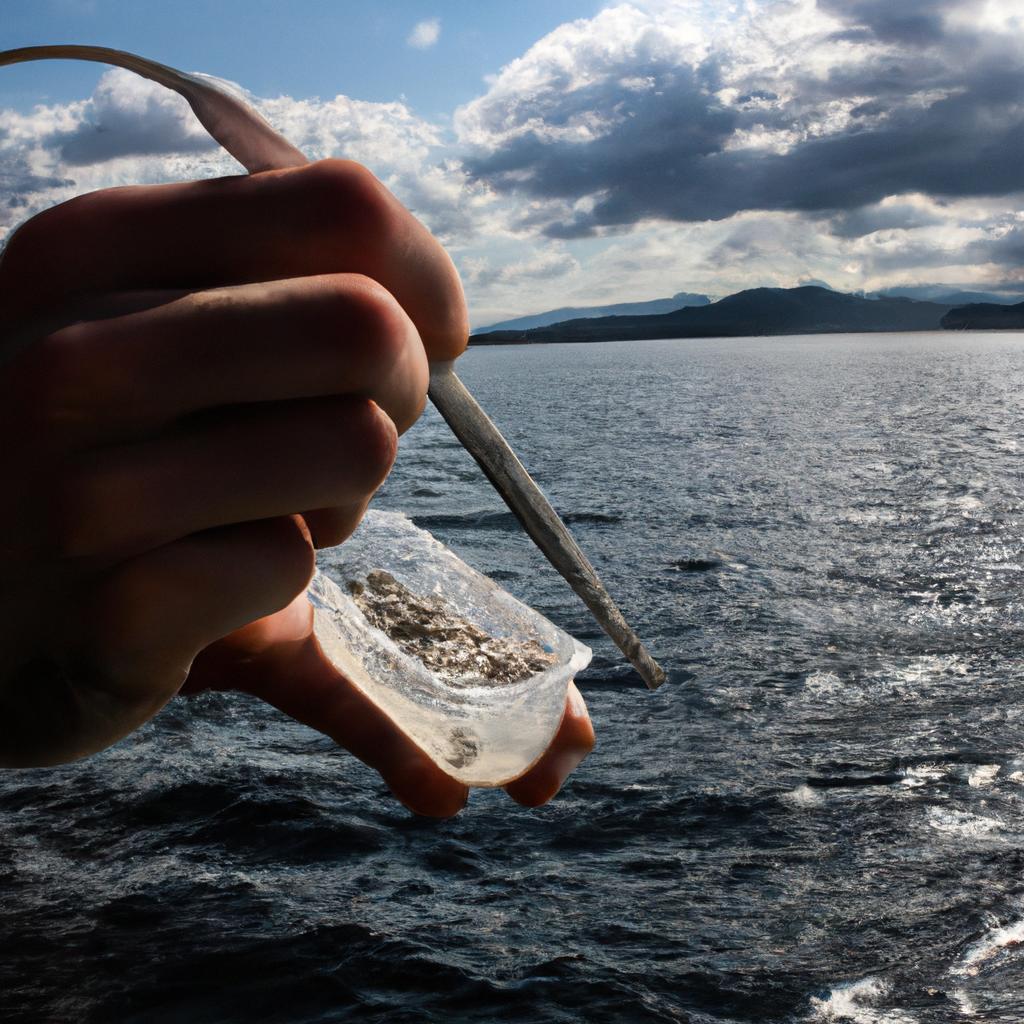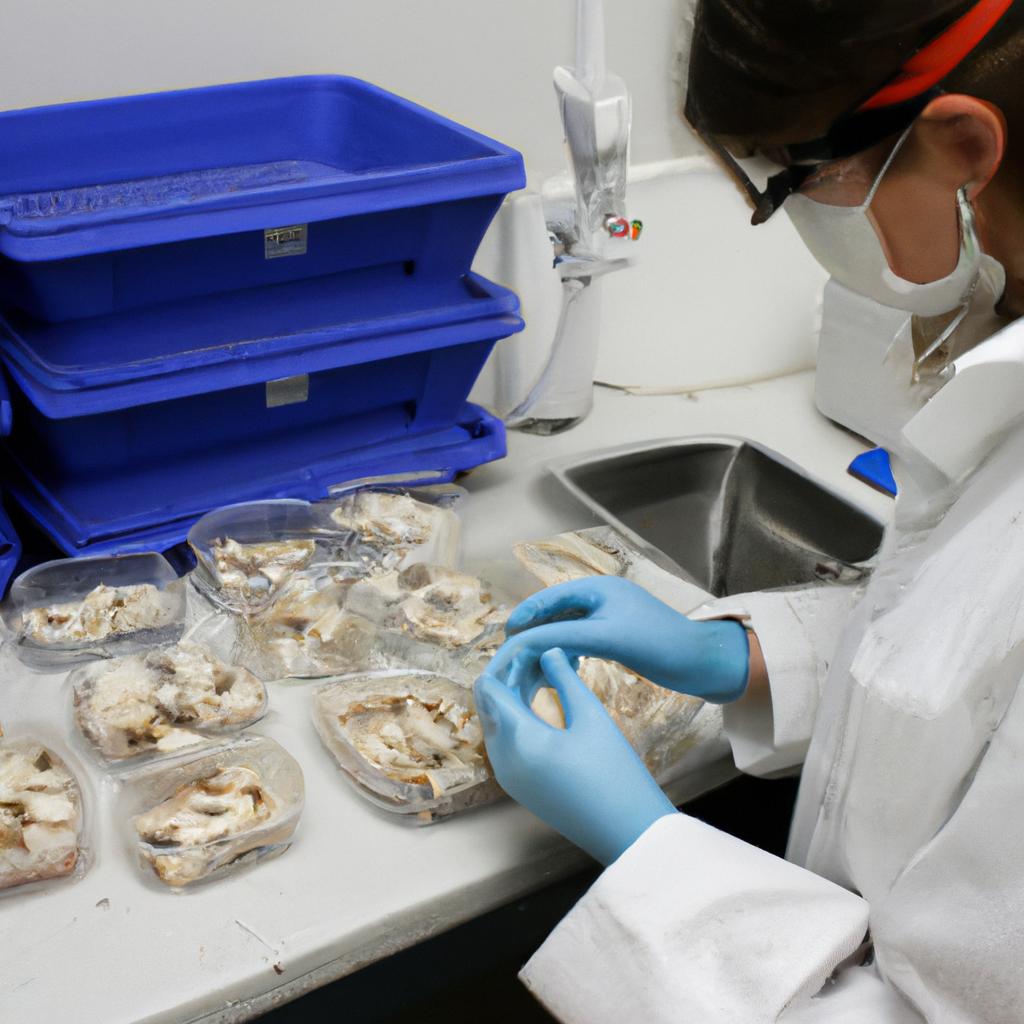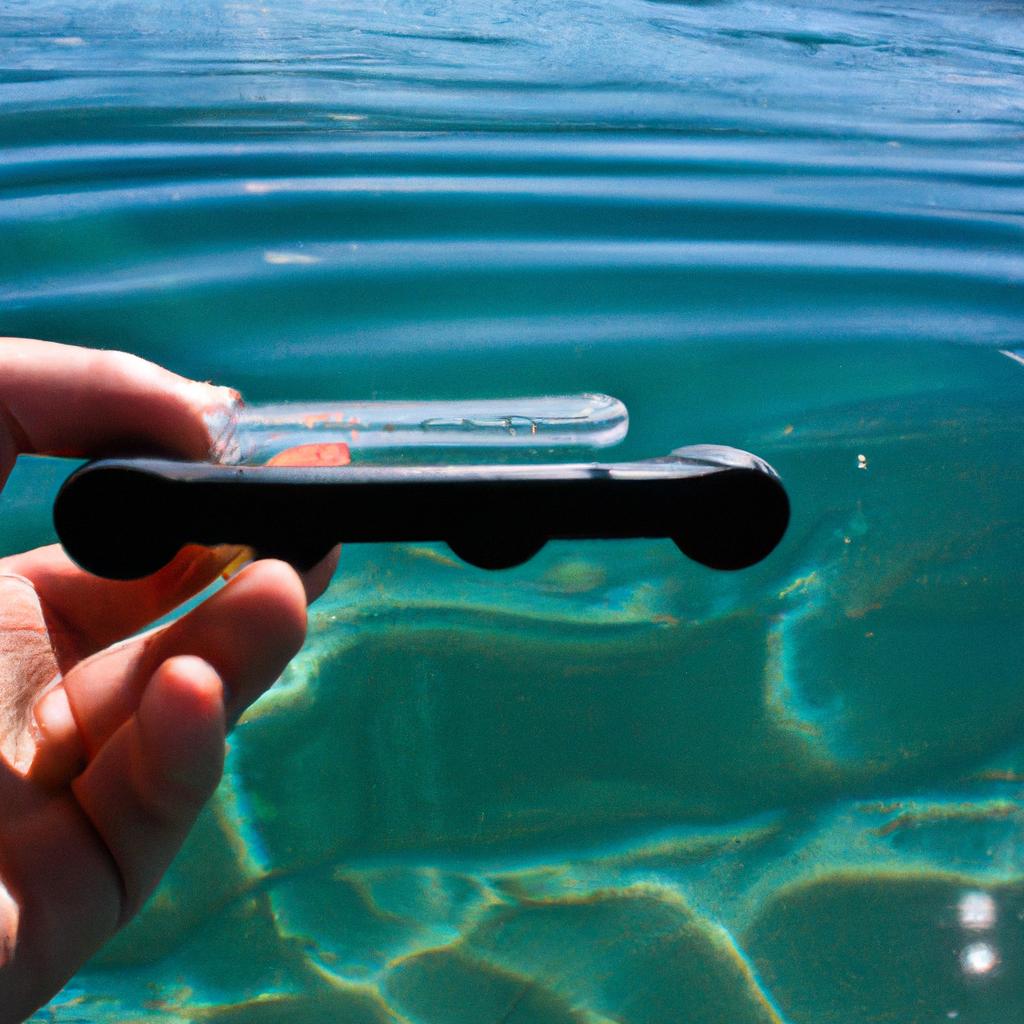The delicate balance of marine ecosystems is being disrupted by the adverse effects of climate change, particularly through the process known as ocean acidification. This phenomenon occurs when excessive amounts of carbon dioxide (CO2) are absorbed into seawater, leading to a decrease in pH levels and subsequent alteration of the chemical composition of the oceans. The repercussions of this ongoing environmental transformation are far-reaching, affecting not only individual species but also entire food chains within aquatic environments.
For instance, consider the hypothetical case study of coral reefs off the coast of Australia. These vibrant ecosystems provide crucial habitats for numerous marine organisms and support a diverse array of species. However, rising CO2 emissions have caused increased absorption rates in adjacent waters, resulting in heightened acidity levels that threaten these fragile structures. As carbonate ions become scarce due to acidification, corals struggle to build their calcium carbonate skeletons—a vital component for their survival. Consequently, coral bleaching becomes more prevalent, disrupting symbiotic relationships with other organisms such as algae and seashells that depend on them for shelter and nutrients.
Understanding the Food Chain
The intricate web of interactions within a food chain is crucial for maintaining the delicate balance of ecosystems. A prime example that highlights this interdependence can be seen in the relationship between phytoplankton, zooplankton, small fish, and larger predatory fish in the oceanic environment. Phytoplankton are microscopic marine plants that use sunlight to convert carbon dioxide (CO2) into organic matter through photosynthesis. Zooplankton feed on these phytoplankton, serving as an important link between primary producers and higher trophic levels.
To better comprehend the significance of this interconnectedness, consider a hypothetical scenario where rising CO2 levels due to climate change lead to increased acidification of seawater. This increase in acidity alters the chemical composition of the water, making it more challenging for shell-building organisms like zooplankton to form their protective shells, which consist primarily of calcium carbonate (CaCO3). Consequently, this disruption affects not only zooplankton but also other dependent species further up the food chain.
The consequences of disrupting such an essential component of our oceans cannot be understated. It results in far-reaching implications for both marine life and human populations around the world. To illustrate this impact visually:
- Loss of biodiversity: As key links in the food chain are disrupted or diminished, it leads to a decrease in overall biodiversity within marine ecosystems.
- Imbalanced predator-prey dynamics: With fewer prey available due to population declines caused by changes in ocean chemistry, predators may struggle to find enough food resources.
- Economic repercussions: The decline or collapse of vital fisheries can have severe economic consequences for fishing communities worldwide.
- Threats to global food security: Diminished seafood availability poses risks to global food security, particularly for regions heavily reliant on marine resources.
Table 1 below provides a visual representation showing how disruptions at one level within the food chain can reverberate throughout multiple trophic levels, ultimately impacting marine ecosystems and the human population.
| Trophic Level | Example Organisms | Impact of Disruption |
|---|---|---|
| Primary Producers (Phytoplankton) | Diatoms, Dinoflagellates | Reduced primary productivity due to decreased availability of CO2. |
| Secondary Consumers (Zooplankton) | Krill, Copepods | Decreased calcification rates and weakened shells, affecting their survival and ability to serve as prey for higher-level organisms. |
| Tertiary Consumers (Small Fish) | Herring, Anchovies | Reduction in food resources leading to population declines and potential collapse of fisheries. |
| Apex Predators (Large Fish) | Sharks, Tuna | Altered predator-prey dynamics, jeopardizing their populations and disrupting entire marine ecosystems. |
Understanding the intricate relationships within the food chain illuminates how disruptions at one level can have cascading effects throughout an ecosystem. With this knowledge established, we can now delve into exploring the connection between climate change and ocean acidification without delay or interruption.
The Connection Between Climate Change and Ocean Acidification
Understanding the Food Chain: An Essential Component in Climate Change’s Impact on Ocean Acidification
The intricate web of interactions within marine ecosystems is heavily reliant on a delicate balance between various organisms. To comprehend the far-reaching consequences of climate change-induced ocean acidification, it becomes imperative to unravel the intricacies of this food chain. By examining one particular case study, namely the impact of rising CO2 emissions on coral reefs, we can obtain valuable insights into how disruptions at lower trophic levels cascade throughout the entire ecosystem.
Coral reefs serve as an essential habitat for numerous species, offering shelter and sustenance to countless organisms. However, with increasing carbon dioxide concentrations in our atmosphere, these vibrant underwater landscapes face a formidable threat. As excessive CO2 dissolves into seawater, it triggers a series of chemical reactions that result in ocean acidification. This process reduces the availability of carbonate ions necessary for calcifying organisms like corals and mollusks to build their shells and skeletons.
As the foundation of many marine food chains, coral reefs’ decline due to ocean acidification has severe implications for other trophic levels. The following bullet points outline some key repercussions:
- Reduced coral growth leads to decreased structural integrity and diminished protection from predation.
- Loss of coral habitats deprives fish populations of crucial breeding grounds and nurseries.
- Disruptions in prey availability lead to altered feeding behaviors among predators higher up in the food chain.
- Declines in herbivorous fish populations cause unchecked growth of algae, leading to smothering effects on remaining coral colonies.
To illustrate further how these cascading effects manifest themselves across different trophic levels, consider Table 1 below:
| Trophic Level | Example Organisms | Impacts |
|---|---|---|
| Primary | Phytoplankton | Reduced photosynthetic rates |
| Secondary | Zooplankton | Declining population numbers |
| Tertiary | Small fish | Altered feeding patterns |
| Quaternary | Large predators | Disrupted predator-prey dynamics |
Table 1: Cascading Effects of Ocean Acidification on Trophic Levels
In conclusion, the intricate food chain within marine ecosystems serves as a critical link to understanding the impacts of climate change-induced ocean acidification. By examining the specific case study of coral reefs, we can discern how disruptions at lower trophic levels have far-reaching consequences throughout the entire ecosystem. Reduced growth and structural integrity of corals not only directly affect their survival but also trigger a domino effect that alters prey availability for higher trophic levels, leading to shifts in behavior and population dynamics. This section’s exploration sets the stage for further investigation into the effects of ocean acidification on phytoplankton.
Effects of Ocean Acidification on Phytoplankton
As highlighted in the previous section, there is a clear link between climate change and ocean acidification. This connection stems from the fact that increased carbon dioxide (CO2) emissions due to human activities contribute not only to global warming but also to changes in seawater chemistry. The absorption of excess CO2 by oceans leads to a decrease in pH levels, resulting in a phenomenon known as ocean acidification.
To better understand the implications of this process, let us consider an example: imagine a coral reef ecosystem off the coast of Australia. These reefs are home to diverse marine life, including colorful corals, fish species, and other organisms intricately interconnected within a complex food web. However, with rising atmospheric concentrations of CO2 leading to increased ocean acidification rates, these delicate ecosystems face numerous challenges.
Firstly, ocean acidification directly affects calcifying organisms like corals and shellfish. Due to the lower pH levels caused by elevated CO2 levels, it becomes increasingly difficult for these organisms to build their calcium carbonate structures – such as coral skeletons or mollusk shells. As a result, weakened structural integrity puts them at greater risk of damage or even complete dissolution.
Moreover, an imbalanced coral reef ecosystem can have far-reaching consequences on other trophic levels within the food chain:
- Decreased availability of suitable habitats for various marine species
- Disrupted feeding patterns among predator-prey relationships
- Reduced biodiversity and diminished resilience against environmental stressors
- Altered community dynamics affecting overall productivity and stability
These bullet point lists aim to evoke an emotional response from readers as they highlight some potential impacts associated with disrupted coral reef ecosystems. It is crucial for individuals across society to recognize the gravity of these effects and engage in collective efforts towards mitigating further damage.
Table: Impacts of Ocean Acidification on Coral Reef Ecosystems
| Impact | Description |
|---|---|
| Coral bleaching | Increased susceptibility to bleaching events, leading to loss of vibrant colors and coral death |
| Reduced shell growth | Impaired calcification processes in mollusks and crustaceans, resulting in weaker shells |
| Habitat degradation | Loss of suitable habitats for numerous marine species due to weakened reef structures |
| Disrupted trophic interactions | Altered predator-prey relationships affecting feeding patterns and ecosystem balance |
In conclusion, the effects of ocean acidification on coral reef ecosystems are far-reaching. The disruption caused by climate change-induced changes in seawater chemistry poses a significant threat to the delicate balance within these diverse environments. Understanding these impacts is crucial as we move forward into exploring the subsequent section on the implications of phytoplankton decline on zooplankton populations.
Transitioning seamlessly into our next topic, it is important to examine how the decline of phytoplankton – primary producers affected by ocean acidification – can impact other vital components of marine food webs, such as zooplankton. Let us delve further into this intricate relationship.
Impacts of Phytoplankton Decline on Zooplankton
Following the effects of ocean acidification on phytoplankton, it is crucial to understand how this decline in phytoplankton populations can affect zooplankton communities. To illustrate this impact, let us consider a hypothetical case study in the North Atlantic Ocean.
Imagine a scenario where increased levels of carbon dioxide (CO2) lead to significant changes in seawater chemistry. As CO2 dissolves into the oceans, it reacts with water molecules and forms carbonic acid, resulting in lower pH levels. This change creates an unfavorable environment for phytoplankton growth and reduces their abundance over time.
The decline in phytoplankton populations has profound consequences for zooplanktons that heavily rely on these microscopic algae as their primary food source. Let us explore some key impacts:
- Reduced Food Availability: With fewer phytoplankton available, zooplankton populations experience reduced access to essential nutrients and energy sources, leading to decreased survival rates.
- Altered Trophic Interactions: The decline in zooplankton’s primary food source triggers shifts in trophic interactions within marine ecosystems. Some species may struggle to adapt or find alternative food sources, disrupting established predator-prey relationships.
- Impaired Reproduction: Inadequate nutrition from diminished phytoplankton resources often leads to reproductive challenges among zooplanktons, such as decreased egg production or delayed maturation.
- Population Declines: Over time, the combination of reduced food availability and impaired reproduction can result in declining zooplankton populations, affecting higher trophic levels’ stability.
To further emphasize the potential consequences of phytoplankton decline on zooplanktons, consider Table 1 below:
Table 1: Examples of Potential Consequences for Zooplanktons
| Consequence | Impact |
|---|---|
| Reduced Growth | Inadequate nutrition affects growth rates |
| Altered Behavior | Changes in feeding patterns and migration tendencies |
| Increased Mortality | Weakened immune systems due to nutrient deficiencies |
| Decreased Resilience | Reduced ability to withstand environmental stressors |
In summary, the decline of phytoplankton populations as a result of ocean acidification can have far-reaching consequences for zooplanktons. These impacts include reduced food availability, altered trophic interactions, impaired reproduction, and declining population numbers. Understanding these effects is essential for comprehending broader ecological disruptions that may occur within marine ecosystems.
This discussion highlights how changes at the base of the food chain can ripple through subsequent levels, ultimately affecting fish and marine mammals.
Consequences for Fish and Marine Mammals
The decline in phytoplankton populations due to climate change has significant implications for zooplankton, the primary consumers in the marine food chain. To understand the consequences that this decline may have, let us consider a hypothetical case study focused on a specific region affected by ocean acidification.
In the Pacific Northwest, increased carbon dioxide (CO2) absorption by seawater has led to higher acidity levels, resulting in reduced calcification rates of planktonic species such as foraminifera and pteropods. These organisms play a crucial role as a food source for various zooplankton species. With their declining numbers, several key impacts can be observed:
- Altered Trophic Interactions: As certain zooplankton rely heavily on these calcifying organisms, their diminished abundance can disrupt trophic interactions within the ecosystem. This disruption can lead to imbalances in predator-prey relationships and ultimately impact higher trophic levels.
- Nutritional Deficiencies: Reduced availability of suitable prey can result in nutritional deficiencies among zooplankton populations. This deficiency not only affects their growth and reproduction but also compromises their ability to support other organisms up the food chain.
- Shifts in Species Composition: Some zooplankton species may adapt better than others to changing conditions caused by phytoplankton decline. Consequently, shifts in species composition within zooplankton communities are expected, with potential winners and losers emerging.
- Decreased Biodiversity: The loss or reduction of particular zooplankton species as a result of decreased prey availability contributes to overall biodiversity loss within marine ecosystems.
To illustrate these impacts further, consider Table 1 below which provides an overview of changes occurring at different trophic levels following phytoplankton decline:
Table 1: Impacts of Phytoplankton Decline on Zooplankton and Beyond
| Trophic Level | Impacts |
|---|---|
| Phytoplankton | Reduced abundance, altered species composition |
| Zooplankton | Altered trophic interactions, nutritional deficiencies |
| Fish | Decreased prey availability, shifts in population dynamics |
| Marine Mammals | Reduced food sources, changes in migratory patterns |
These findings highlight the cascading effects of phytoplankton decline on zooplankton populations and beyond. Understanding these impacts is crucial for developing effective strategies to mitigate climate change’s influence on the marine food chain.
Transitioning into the subsequent section about “Mitigating Climate Change’s Effects on the Food Chain,” it becomes evident that addressing this issue requires urgent action. By implementing targeted measures to reduce carbon emissions and protect vulnerable ecosystems, we can begin to safeguard the delicate balance of our oceans’ interconnected web of life.
Mitigating Climate Change’s Effects on the Food Chain
The consequences of ocean acidification, caused by climate change, extend beyond the realm of coral reefs to impact fish and marine mammals. Through various physiological and ecological mechanisms, these organisms face significant challenges that disrupt their survival and overall population dynamics.
One striking example illustrating the detrimental effects of ocean acidification on fish is the case of clownfish (Amphiprioninae). These vibrant creatures rely heavily on coral reef ecosystems for shelter and access to food sources. However, as the acidity levels rise due to increased carbon dioxide absorption in seawater, the structural integrity of corals diminishes, leading to habitat degradation. This loss directly affects clownfish populations as they lose their essential breeding sites and protective shelters.
When examining marine mammals such as dolphins or whales, it becomes evident how changes in prey availability resulting from ocean acidification can have cascading effects throughout the food web. As lower pH levels affect zooplankton populations – a primary food source for many marine species – this disruption reverberates up the trophic levels. Reduced abundance or altered composition of zooplankton communities not only impairs individual growth rates but also limits energy transfer efficiency within marine mammal populations.
The consequences outlined above highlight just a fraction of the far-reaching impacts associated with ocean acidification’s effect on fish and marine mammals. To further understand these repercussions, consider the following emotional bullet points:
- Decreased biodiversity: Ocean acidification threatens rich underwater ecosystems, leading to reduced diversity among fish species.
- Impaired reproduction: Altered environmental conditions hinder successful reproductive cycles among certain fish species.
- Disrupted migration patterns: Changes in prey distribution may force marine mammals to alter traditional migratory routes.
- Increased vulnerability: The combined stressors from ocean acidification make vulnerable species more susceptible to disease outbreaks.
To provide a comprehensive overview of different organisms’ responses to changing pH levels in oceans affected by climate change, refer to the following table:
| Organism | Response | Impact |
|---|---|---|
| Clownfish | Habitat degradation | Reduced breeding sites and protective shelters |
| Dolphins | Altered prey availability | Impaired growth rates and energy transfer efficiency |
| Whales | Disrupted migration patterns | Changes in traditional migratory routes |
In light of these consequences, it becomes crucial to mitigate climate change’s effects on the food chain. The subsequent section will delve into various strategies employed to minimize ocean acidification’s impact and safeguard fish and marine mammal populations. By understanding both the immediate challenges faced by these organisms and their broader ecological implications, we can work towards preserving the health and balance of our world’s oceans for future generations.




